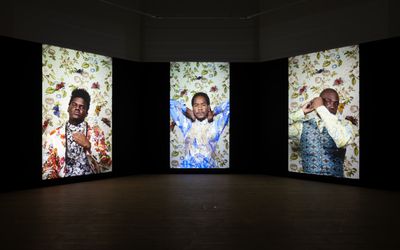Ebony G. Patterson…for those who come to bear/bare witness…
–
–
Due to COVID19 restrictions, the exhibition by Ebony G. Patterson won't return.
Kunsthal Aarhus presents the first institutional solo exhibition in Europe of artist Ebony G. Patterson (b. 1981, Kingston, Jamaica). The show, …for those who come to bear/bare witness…, stages an immersive installation of recent works emulating the environment of a nocturnal garden—a site that evokes myth and beauty, as well as violence and ornamentation. At once foreboding and enchanting, the work wealds embellishment as a critical device to confront notions of burial, invisibility, and mourning. Transforming the galleries into a sacred landscape that conjures an experience of the religious and the sublime, the exhibition centers upon three key works in Patterson’s practice that examines the black body, coalescing oppositions such as the biblical and the secular, the exotic and the domestic, and the global and the personal, through representations of loss. As the title of the exhibition suggests, the witnessing Patterson articulates is one of weight; the dual meaning of ‘bear’ and ‘bare’ lead us to consider uncovering and withstanding the burden of what it truly means to confront images of death and resurrection.
“I have often been, or for some time been, preoccupied with the ideas around witnessing and what it means to witness and whose voices are allowed to participate in the act of witnessing. The word bare, b-a-r-e, and the word bear, b-e-a-r, are juxtaposed to consider the weight of what it means to witness. So, there is a sense of vulnerability that happens in witnessing as well as thinking about the weight of witnessing and what voices in our society are given weight.”
– Ebony G. Patterson
Set against a backdrop of wilting flora at dusk, an encompassing wallpaper of petals and leaves absorbed in the deep violet cast of a dying sun, Patterson’s floor and wall-based tapestries draw us close. In ...among the flowers between the blades...while the dew is on the roses...for those who bear/bare witness (2018), the artist elaborately combines patterned textiles, bejeweled beadwork, artificial flowers, glitter, plastic pearls, and the shells of gold bullets to simultaneously camouflage and reveal human figures. Layered in excess, embedded within what one may term a Neo-Baroque style, the recognizable fragments of bodies, garments, and living creatures are consumed by adornment, yet discernible in hiding. Through the aesthetics of “bling” culture—a display of abundance that withstands across the artist’s practice—limbs come into focus, like phantoms, among the lushness of Patterson’s botanical scapes. Within the post-colonial context the archetype of the garden takes on potent meaning. The history of Western travel financed by colonialism to ‘exotic’ lands led to the acquisition and theft of plants and species— but one aggression wrought by imperialism through forceful theft and violent removal—for the purpose of display in national gardens and personal menageries.
Patterson reclaims this colonialist aspiration to instead articulate images of absented Black bodies wrought by the trauma of conquest, making what is often overlooked unapologetically visible. The title of the work, ...among the flowers between the blades...while the dew is on the roses...for those who bear/bare witness, references the popular 1912 hymn written by Charles Austin Miles, “In the Garden,” which tells the story of Mary Magdalene as she walks through the dark garden alone to discover an empty tomb, “while the dew is still on the roses.” In place of Christ, she finds an absence. While the scene in Miles’ gospel is set before the sun has risen, it is important to note that dew also forms in the evening under certain conditions. On blades of grass, on spider webs, among the flowers. It is this setting, on a warm, clear day followed by a sharp, cool evening, that we can imagine Patterson’s dew forming; it belongs to the aftermath, not the commencement. To the day that is dying.
This allegory of mortality is an essential facet of Patterson’s work. Hovering above the floor, like magic carpets, Root and Shrub, Root and Shrubz (2014) are two large-scale tapestries that feature lustrous surfaces of lace and rhinestones. Beneath the alluring veneer, the photography-based fabric works feature prostrate bodies, inspired by images of a dead child taken by pedestrians following the murder of a toddler in a housing complex for the purpose of being shared online. Challenging the removal of humanity implicit in the dissemination of dead Black bodies on social media platforms, Patterson’s indulgence in ornament is as sensual as it is political. Beyond the aesthetics of seduction, Patterson’s work demands a heightened re-sensitization of our vision. These images, these works, cannot be scrolled past.
“Accounting requires witnessing. And what does it mean to witness? It means looking, it means thinking but most importantly it means listening and giving weight and value to the voices that have been dismissed.”
– Ebony G. Patterson
The artist makes clear that to bear witness requires an attuned awareness—of looking instead of seeing. They deny the anonymity of death.
In the three-channel video installation, …three kings weep… (2018), the projection begins with the image of three shirtless Black men against brightly colored floral backdrops. Adopting the vernacular of a term of respect for young men, the term ‘king’ also carries additional religious context within the chapel-like setting of the work. The tripartite structure of the film alludes to the biblical king—of God, the Son, and the Holy Spirit. As the work progresses and the men begin to dress themselves, we notice that this is not an adornment of clothes, but a stripping of garments and accessories playing in reverse. Over the course of eight-minutes, the predominant silence of the work is interrupted by an off-screen voice that recites lines from the 1919 poem “If We Must Die” by Jamaican poet Claude McKay. We hear one particular line:
"What though before us lies the open grave?
Like men we’ll face the murderous, cowardly pack,
Pressed to the wall, dying, but fighting back!"
The faces of the men stare out into the empty gallery that surrounds the viewer, streaks of tears running along their cheeks. Their sadness is an ornamentation of loss, a décor of water, that simultaneously performs humanity. As the dew collects upon a rose, so too do the droplets gather on their faces; they weep a collective trauma, shining beautifully in the garden, against a tangle of thorns.
“To use these bodies and position them in this way is also suggesting or also saying that these bodies are worthy
of this kind of space. And that the way these bodies operate in their own day to day already projects that they are worthy of occupying this space and in many ways, they are not waiting for anybody to allow them to occupy these spaces.”
– Ebony G. Patterson
Artist Biography
Supported by







